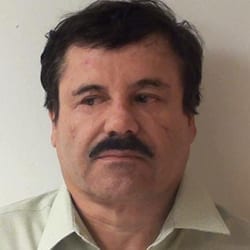Mexican kingpin to face U.S. justice
Today (1/20), Chapo Guzman arrived in New York to face justice in the U.S. Chapo Guzman has been called the world’s richest man and alternately, the world’s most wanted man, for allegedly moving tons of cocaine and vast quantities of methamphetamine and heroin into the United States from Mexico — as well as allegedly committing many other crimes such as murder and torture during his reign as the leader of the Sinaloa Cartel, perhaps the most powerful of the Transnational Criminal Organizations operating south of the U.S. border. Over the last 20 years, Guzman has been indicted by the U.S. Department of Justice (DOJ) in federal district courts from coast to coast, including in New York, California, Texas and Illinois.
It is no coincidence that Guzman was sent to New York to face trial. Among several legal considerations, 21USC959, known as the “long arm of the law” provision, mandates that a person “shall be tried in the United States District Court at the point of entry where such person enters the United States, or in the United States District Court for the District of Columbia” (1) for any acts committed outside territorial jurisdiction of United States. New York is also the jurisdiction where the most current indictment was handed down in 2014, so it makes sense that the DOJ would take him there first.
Stale evidence pitfall
Whether or not Guzman receives a sentence commensurate with his crimes is directly related to how well the federal agents conducting the investigations into Guzman’s illegal activities have preserved the evidence against him. Often, the longer it takes to get an indictment, the greater the chance that evidence becomes stale or that witnesses die/become unwilling to testify against the defendant. This deterioration of evidence or testimony can make a difference in sentencing and may impact the federal government’s ability to impose a punishment that fits the crime.
A perfect example of the pitfalls of stale evidence was seen in the sentence of Osiel Cardenas, the Mexican kingpin who headed the Gulf Cartel. Osiel Cardenas was indicted in 2000, extradited in 2007 and tried in U.S. courts for crimes that included moving several tons of cocaine into the U.S., intimidation of law enforcement officials and his personal threats in 1999 to kill DEA and FBI agents in Mexico. Many U.S. agents were disappointed and angered to learn that Cardenas received a relatively short 25-year sentence when his trial ended in 2010; the punishment at least in part reflected the government’s inability to preserve evidence as time passed. (2) The Osiel Cardenas case, and many others like it, allowed the DOJ to “check the box” that indicated a successful prosecution; “justice was served” even though the punishment was relatively minimal when compared to the severity of crimes committed. As a point of comparison, some of the street-level drug traffickers who won pardons or commuted sentences in President Obama’s last days in office, most of whom are U.S. citizens, originally received harsher sentences than Cardenas, making the impact of the Cardenas sentence appear rather trivial.
Corrupt government officials
That said, whether or not Chapo serves a long sentence could be secondary to his possible cooperation and testimony against others in Mexico and the U.S. Such information could be more beneficial than a prison sentence; it could deepen our understanding of how organized crime has succeeded and prospered. Mexican drug cartels could not operate successfully without the corruption that allows them to conduct their trade in both the U.S. and Mexico. Chapo’s prosecution will likely open a Pandora’s box that could expose corrupt officials in both countries.
As in the case of Osiel Cardenas, Chapo Guzman’s defense attorneys will likely strike a “proffer” deal with DOJ that could result in his testimony against others. If history is a guide, the insight that Chapo may provide into the influence and corruption that made him successful is likely to result in a reduced sentence. While such testimony would be beneficial, as noted, his sentence will nevertheless leave many wondering if justice was truly served.
[1] 21 USC 959: Possession, manufacture, or distribution of controlled substance; http://uscode.house.gov/view.xhtml?req=(title:21%20section:959%20edition:prelim).
[2] FBI Houston Division Press Release, “Osiel Cardenas-Guillen, Former Head of the Gulf Cartel, Sentenced to 25 Years’ Imprisonment,” Feb. 24, 2010, https://archives.fbi.gov/archives/houston/press-releases/2010/ho022410b.htm.
Gary Hale is a nonresident fellow in drug policy and Mexico studies. From 2000 to 2010, he was chief of intelligence in the Houston Field Division of the Drug Enforcement Administration. From 1990 to 1997, Hale had various assignments in Washington, D.C., including serving as chief of the Heroin Investigations Support Unit, chief of the Dangerous Drugs Intelligence Unit and liaison to the National Security Agency. During this period, he also served a tour of duty at the U.S. Embassy in Bogotá, Colombia. From 1997 to 1998, Hale was assigned as the DEA intelligence chief at the U.S. Embassy in Mexico City.
